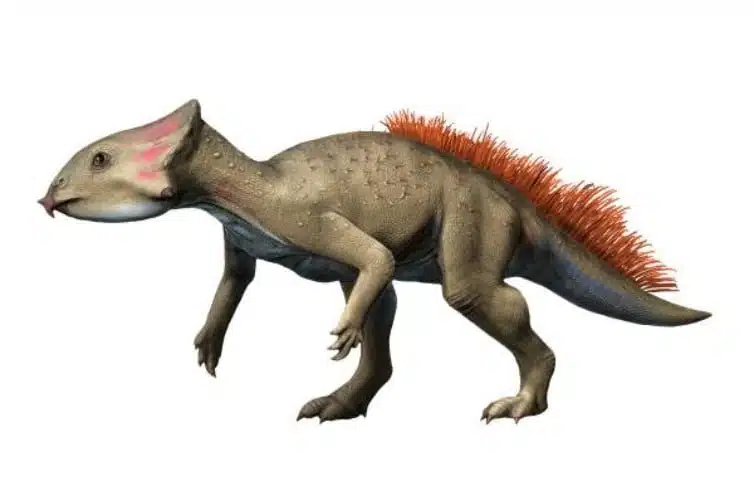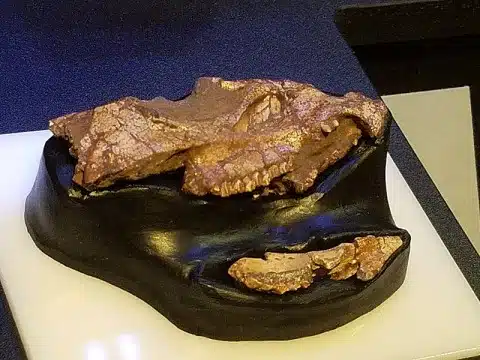Aquilops americanus was a ceratopsian dinosaur that lived in modern day North America during the Early Cretaceous period. A small dino by any standard, it got its name americanus as it was the first basal neoceratopsian to have been found in America.
Aquilops Key Facts
| Keyword | Fact |
|---|---|
| Aquilops pronunciation | ah-kwih-lops |
| Meaning of name | Eagle face |
| Group | Ceratopsia |
| Type Species | Aquilops americanus |
| Diet | Herbivore |
| When it Lived | 109.0 to 99.6 MYA |
| Period | Early Cretaceous |
| Epoch | Middle Albian to Late Albian |
| Length | 1.8 to 2.0 ft |
| Height | 1-1.2 ft |
| Weight | 3-4 lbs. |
| Mobility | Moved on two legs, or all four |
| First Discovery | 1997 by Scott Madsen |
| Location of first find | Montana, USA |
| First Described by | 2014 by Andrew Farke, W. Desmond Maxwell, Richard Cifelli and Mathew Wedel |
| Holotype | OMNH 34557 |
Aquilops Origins – Taxonomy, Timeline, and Discovery

Aquilops, name is derived from the Latin “aquila” for “eagle” and the Greek “ops” for “face.” It was given the name based on its beaked face that bears a striking resemblance to that of an eagle. This unique characteristic sets it apart from many of its dinosaur contemporaries.
Belonging to the Ceratopsia group, A. americanus is a member of the group of herbivorous dinosaurs known for their beaked faces and frilled necks.
Aquilops lived during the Early Cretaceous period, specifically from the Middle Albian to Late Albian epoch. between 109 to 99.6 million years ago.
The first discovery of the Aquilops was made in 1997 by paleontologist Scott Madsen in Montana, USA. However, it wasn’t until 2014 that it was first described by American paleontologists Andrew Farke, W. Desmond Maxwell, Richard L. Cifelli, and Matthew J. Wedel. This gap between discovery and description is not uncommon in paleontology, as the process of extracting and studying fossils is often a lengthy one.
Fossil Evidence

The first and only known specimen of this dinosaur was found by Scott Madsen in 1997 in Montana, USA. At first, it was thought to be a specimen of Zephyrosaurus, but further examination revealed it to be a new species entirely. This partial skull, found in Carbon County in southern Montana, was the first of its kind, marking a significant find among ceratopsians.
It wasn’t until 2014 that this fossil was officially described by a team of paleontologists including Andrew Farke, W. Desmond Maxwell, Richard L. Cifelli, and Matthew J. Wedel. This team undertook the task of studying the fossil in detail, eventually determining that it represented a new species within the Ceratopsia group.
The Aquilops fossil is particularly notable due to its well-preserved state. Despite being over 100 million years old, the fossil retains many of its original features, allowing scientists to gain valuable insights into the physical characteristics and lifestyle of this ancient creature. The fossil evidence of Aquilops is limited to this single specimen, but it has nonetheless provided a wealth of information about this unique dinosaur.
Aquilops Size and Description
The Aquilops is a fascinating creature, not just for its unique characteristics, but also for its rather moderate size. Despite being a member of the Ceratopsia group, known for their large, frilled dinosaurs, the Aquilops was relatively small.
Short description of Aquilops
More than just being a small dinosaur, it had a body shape that was compact and agile. Its most distinctive feature was its beaked face, which gave it its name. Based on other ceratopsians, it most likely had a short neck and a long tail, which it used for balance. Its limbs were robust, indicating that it was a capable runner. The Aquilops moved bipedally, on two legs, a trait that is common among smaller dinosaurs. The skin of the Aquilops is not well known, but it is likely that it had a covering of scales, like many other dinosaurs.
Size and Weight of Type Species

The estimated body length of Aquilops is 2.0 ft with, weighing 3-4 lbs. This size estimate is based on the fossil evidence available, which includes a well-preserved skull that measures 84.2 mm in length. It’s important to note, however, that the fossil specimen is believed to be from a subadult individual, so the full-grown size of the Aquilops may have been slightly larger.
The Dinosaur in Detail
The beaked face of the Aquilops, the feature that earned it its name, was a unique adaptation among its dinosaur brethren. This beak, reminiscent of an eagle’s, was not just a defining characteristic but a survival tool, enabling it to efficiently consume the plant matter that made up its diet.
Another intriguing aspect of the Aquilops is its antorbital fenestra, a skull opening that was twice as long as it was tall and had a pointed rear below the eye socket. This is a feature not commonly seen among dinosaurs, further setting the Aquilops apart from its contemporaries.
Despite its size, the Aquilops was likely a nimble creature, its compact and agile body allowing it to navigate its environment with ease. This agility would have been a key survival trait in the Early Cretaceous period, a time when the Earth was home to a wide array of predators.
The Aquilops in its Natural Habitat and Environment
It lived during the Early Cretaceous period, a time of significant environmental change. The western part of North America was its home—a paleocontinent known as Laramidia. The climate was warm, and sea levels were rising, resulting in a world rich in vegetation and diverse ecosystems.
As an herbivore, it would have relied heavily on the abundant plant life for sustenance. Its beaked face, a unique adaptation among dinosaurs, would have been particularly useful in this regard, allowing it to efficiently consume a variety of plant materials.
Its bipedal locomotion would have given it a speed advantage over many other herbivores, enabling it to quickly escape from predators. It’s also possible that the Aquilops lived in groups, as many herbivorous dinosaurs did to provide additional protection from predators.
Its senses would have played a crucial role in its survival. While we don’t know much about its specific sensory capabilities, it’s likely that it had keen eyesight and a strong sense of smell, which would have helped it find food and avoid predators.
Interesting Points about Aquilops
- It is the oldest and most primitive neoceratopsian known from North America.
- Despite being a member of the Ceratopsia group, known for their large, frilled dinosaurs, it was relatively small.
- Its beaked face is its most distinctive trait, setting it apart from many other dinosaurs of its time.
- It had a unique skull opening, known as the antorbital fenestra, which is not common among dinosaurs.
- It was a bipedal dinosaur, meaning it moved on two legs, a trait that is common among smaller dinosaurs.
- Its small size and agile nature would have allowed it to have a significant impact on its environment. By consuming plant matter, it would have helped to shape the landscape around it, contributing to the overall biodiversity of its ecosystem.
Contemporary Dinosaurs
It shared its world with an intriguing group of contemporaries. These fellow Laramidian dinosaurs were integral parts of a complex ecosystem.
One contemporary was the Deinonychus, a dinosaur significantly larger than the Aquilops. This predator, with its sharp claws and swift movements, might have posed a considerable threat to the A. amaericanus. However, Aquilops, being small and agile, could have used its size to its advantage and nimbly navigated the terrain to evade such predators. This dynamic paints a vivid picture of the constant dance between predator and prey, a testament to the survival instincts of the Aquilops.
Then there was the Dryptosaurus, another larger contemporary. Unlike the Deinonychus, the Dryptosaurus was not as swift, but its size and strength could have made it a formidable presence.
Lastly, I am including Tenontosaurus, an herbivorous dinosaur like the Aquilops. Despite being of a similar diet, the Tenontosaurus was considerably larger. Their size difference likely meant they grazed at different levels, allowing them to coexist without direct competition. This relationship underscores the intricate balance within their shared ecosystem, each species playing its part in maintaining the harmony of their prehistoric world and challenging the Aquilops in their own ways.
Frequently Asked Questions
The name translates to “eagle face,” a reference to its distinctive beaked face.
It lived during the Early Cretaceous period, specifically from the Middle Albian to Late Albian epoch, which is approximately 109 to 99.6 million years ago.
As an herbivore, it would have consumed a variety of plant materials.
The first and only known specimen was discovered in 1997 by paleontologist Scott Madsen in Montana, USA
It was a small dinosaur, with an estimated body length of up to 2.0 ft and a weight of approximately 0.002 tons.
Sources
Article last fact checked: Joey Arboleda, 12-24-2023
Featured Image Credit: Nobu Tamura, CC BY-SA 4.0 https://creativecommons.org/licenses/by-sa/4.0, via Wikimedia Commons
